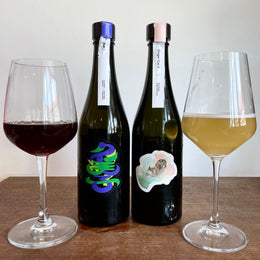
Daishichi is a brewery that's often associated with the ancestral Kimoto method of Sake making because they do such a great job at that - we previous tried a couple of Daishichi's Sakes here.
For simplicity, the Kimoto method goes back to a time before the availability of industrial lactic acid that is needed to jolt a yeast starter to get it going so that the Sake will begin fermentation. Therefore what was necessary back in the day was for Sake brewers to use wooden sticks in order to mash a small batch of rice, water and koji until the mixture begins to warm up and lactic acid would begin to form.


Brewers producing the Sake starter.
In the realms of Sakes, it's rather well-recognised that the Kimoto method does yield some different results versus the more modern industrial process - it tends to create more creamy, richer and softer Sakes. And that is why some breweries have gone back to the Kimoto method - however given how labour and time intensive it is, requiring much more skill as well, it's usually reserved for special editions.
However, Daishichi is pretty much focused on this style and so everything from the brewery comes from the Kimoto method. And to that end, very interestingly, today we'll get to try a Umeshu that is produced using Sake that is made with the Kimoto method. This might actually be a first!

Wakayama is where the best Umes are from.
And at least for Daishichi, this is their first foray into producing liqueurs, and where better than to start with Japan's favourite Umeshu - liqueur produced by soaking Ume fruit in an alcohol base. Typically, Umeshu is produced using a Shochu base, however, in this case Daishichi has opted to use their flagship Junmai Sake. This is used along with Nanko Ume from Wakayama Prefecture - the best spot for Ume farming.
Let's give it a go!
Daishichi Kimoto Umeshu, 12% ABV | 大七酒造 生酛梅酒 - Review

Tasting Notes
Color: Orange Jelly
Aroma: Bright syrupy orchard fruits - jams and jelly cups, perhaps more specifically orange jam, apple jelly cups and also a light tartness of yuzu.
Taste: Surprisingly clean flavours, lightly sweet with apple and green grape jelly cups. There’s also a light tartness of that ume fruit. It’s a very nice delicate sweetness and bright fruitiness that comes with a warmer autumnal note of fall leaves.
Finish: Lingering fruit jelly cup sweetness.

My Thoughts
Absolutely lovely.
This isn’t one of those heavy, super densely sweet umeshu’s - no, no, this is brilliantly bright and lifted, yet incredibly flavourful. It comes on a glistening texture that strikes the palate as utter fruit jelly cups, but at the same time is contrasted with warmer autumnal flavours.
Fantastic flavour profile with some solid balance and complexity.
This is the umeshu for those who find standard umeshu’s far too dense or sweet.
My Rating: 8/10
Score/Rating Scale :
- 9-10 : Exceptional, highly memorable, 10/10 would buy if I could.
- 7-8 : Excellent, well above most in its category, worth considering buy-zone.
- 4-6 : Good, okay, alright; a few flaws, but acceptable; not bad, but not my personal preference; still worth trying, could be a buy if the price is right.
- 1-3 : Not good; really did not enjoy; wouldn't even recommend trying.
- 0 : Un-scored, might be damaged, new make, or very unusual.
Kanpai!

@111hotpot







